Poise in the wilderness: Students scout out rescue, life-saving skills
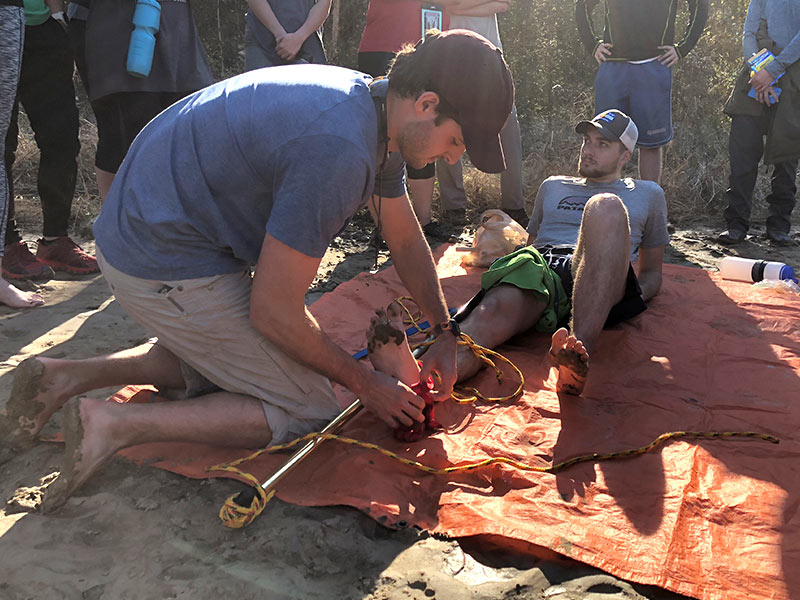
While the kayaking daytrip on the Pearl River was mostly uneventful, there was a snake sighting, a bee stinging and a leg splinting.
Still, the snake didn’t bite and the stinger didn’t stick. And no legs had been harmed; it was just a demonstration.
“We were all good,” William Salaun said, “but we were prepared.”
Salaun, a second-year medical student, is the event coordinator for the Wilderness Medicine Student Interest Group at the University of Mississippi Medical Center.
On November 18, he and close to 30 other M2’s immersed themselves for hours in the type of training their group’s name implies, on the kind of outing that doesn’t always turn out so trauma-free for hikers, backpackers, kayakers and others who are not prepared.
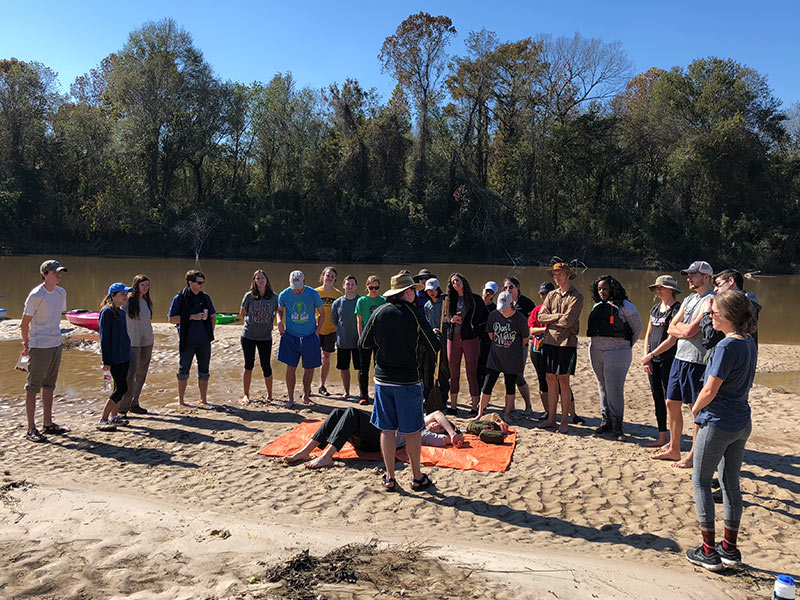
In rough country, where ordinary ailments are confronted under extraordinary situations, providers of emergency care are buffeted by time and distance – from the hospital. Resources for injuries may be scarce.
So, or their educational exploit on the Pearl, the kayakers also brought along a canoe supplied with first aid kits, warm clothes, UV protection, extra clothing, waterproof bags, food, water and PFD’s – personal flotation devices, which some people refer to as “lifejackets.”
In addition to those emergency supplies, improvisation may be required. Also: a water purifier.
“Definitely, you need a water purifier,” said Ruth Fowler of Madison, the group’s treasurer, who also participated last June in a less-than-perfect outing in California’s Yosemite National Park. “We ran out of water for about four hours,” she said.
“I guess someone would have given us some if we had asked.”
Fowler and her companions survived nicely, because they weren’t exactly fish out of water, even if they were out of water. One way to avoid that inconvenience is to engage in strenuous planning – the first watchword of wilderness medicine. The others are patient assessment and evacuation.
In the wilderness, though, the injured may not be the only ones who need to be planned for, assessed and evacuated. Rescuers and emergency care providers are also at risk – from exposure to the elements and injuries themselves.
This milieu is often attractive to emergency medicine providers, or anyone with an ER personality.
“But no matter which specialty you pick, wilderness medicine is useful to know,” said Fowler, who joined the military two summers ago and plans to do her residency in the U.S. Army. “I’m learning skills that will be helpful in deployment.”
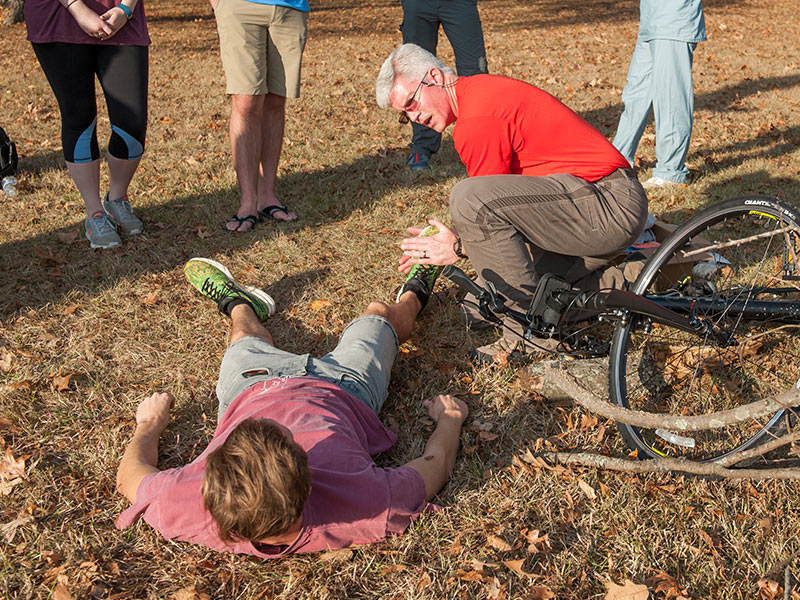
Those skills are invaluable to Jeremiah Reese of Brandon, a backpacking enthusiast who is profoundly aware that others will turn to him in the face of a wilderness emergency.
“As a physician, I will have a responsibility to be able to handle those situations,” said Reese, the student interest group’s community service coordinator “I will be expected to know what to do.”
In this country, there are many opportunities for such expectations: The Outdoor Industry Association reports that nearly 49 percent of the U.S. population older than age 6 embarked on an outdoor activity at least once in 2017, most often jogging and trail running.
More than 13 million Americans that same year plunged into outdoor pursuits for the first time or resumed them after a significant interval.
Many of those first-timers, or some twelfth-timers, for that matter, may not have possessed the know-how to endure, or help others endure, life-threatening accidents, attacks and weather.
But you don’t have to take a course in wilderness medicine to learn basic precautions. When asked to list them, Salaun, Fowler and Reese came up with these:
- Let someone know where you’re going and how long you’ll be there.
- Know basic first aid and bring a kit.
- Wear clothing suited to the environment you’re exploring.
- Bring sun protection.
- Be in shape.
- Determine rendezvous points for members of the group in case they are separated.
- Bring a map and compass – and learn how to use them.
And don’t forget the water purifier, Fowler said.
Also, don’t underestimate the merciless power of Mother Nature. This may sound like an appetizer for the Apocalypse, but poisonous bites, lightning strikes, broken bones, injured spines, torn flesh, hypothermia, hyperthermia, gastroenteritis (“stomach flu”) and a host of other emergencies have been known to occur in the realm of vicious snakes, malevolent spiders, angry bears, moving water, spoiling food and falling rocks.
Citing information from U.S. National Parks in 2014, a World Journal of Emergency Medicine article states that wilderness medicine specialists most often treat sprains, strains, soft-tissue lesions and fractures to the lower extremities.
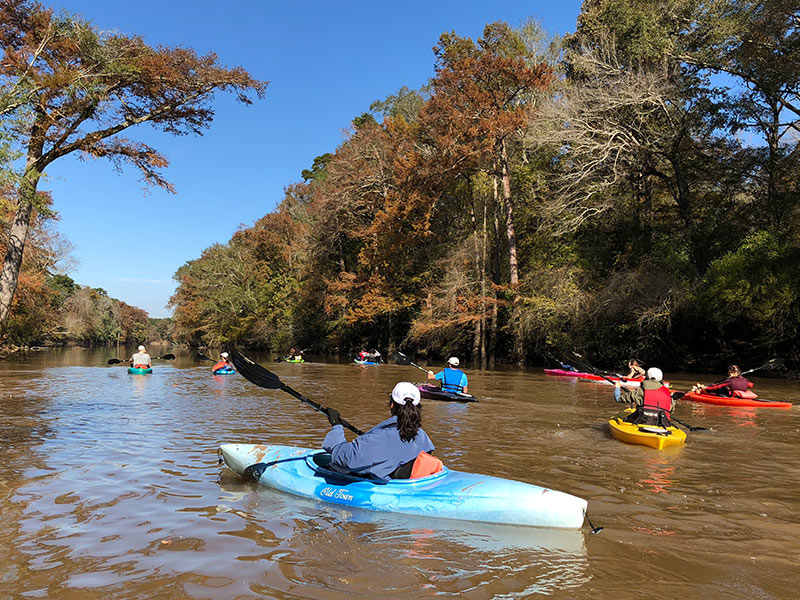
True, during the wilderness medicine crew’s 12-mile paddle on the upper Pearl, no bears, rocks, sprains or strains menaced. But, on their journey from the Old Highway 13 bridge south of Carthage to the Leake County Water Park, there was a snake; apparently, judging from photos Reese took, it was a Coluber constrictor priapus, also known as a black/blue, runner/racer: non-poisonous, but not non-biting.
There was also the bee sting. “But the stinger didn’t stay in,” Fowler said. If it had, the victim could have had an allergic reaction.
As for the leg splint, the splint-ee was an actor named Daniel Glover – that is, Reese’s roommate, a UMMC contractor who co-starred in an injury scenario as “the victim.” This occurred during one of the seminars staged on sand bars, as Salaun administered a traction splint useful for stabilizing and supporting a broken femur, or thigh. He used a canoe paddle on Daniel Glover.
“I intended to demonstrate how to make a traction splint with the materials available,” Salaun said. “Since I was canoeing, it seemed fitting.” He’s had plenty of practice.
A trained outdoors educator, guide and wilderness first-responder, Salaun is planning to embellish an emergency medicine residency with a follow-up fellowship in wilderness medicine. Fifteen institutions in the U.S. offer such fellowships, according to the Emergency Medicine Residents’ Association.
The nearest to Mississippi are the Medical College of Georgia in Augusta, and Virginia-Tech Carillion in Roanoke. But wilderness medicine is not for physicians only. Collaborating with the University of Utah and the University of Colorado, the Wilderness Medical Society awards diplomas in mountain medicine, dive and marine medicine, and disaster medicine.
The WMS also created a master’s degree program with a certification in wilderness medicine sub-disciplines; and it supports student interest groups like the one at UMMC, whose total membership is around 100, Salaun estimates.
Areas of interest in emergency medicine include high-altitude travel, dive medicine, avalanches and much more, but the UMMC students concentrate on Mississippi-specific threats.
“Deer-stand falls,” Fowler said, fingering an obvious hazard for the many Mississippians who hunt. Also on the risk menu: bites from cottonmouths (water moccasins) and copperhead snakes, as well as from black widow spiders and the dreaded brown recluse.
Although the journey on the Pearl was mainly for M2’s, the interest group embraces all School of Medicine classes and is open to all learners on the Medical Center campus. Students from other schools, including the School of Health Related Professions, have signed up for the group’s events, at the invitation of the organization’s current president, Hannah Miller.
Tapping into the expertise they see all around them, the students have invited physicians to teach them; among the most recent presenters are Dr. Bob Galli, UMMC professor of emergency medicine, and School of Medicine alumnus Dr. Philip Blount, a Methodist Rehabilitation Center physician board certified in physical medicine and rehabilitation.
The group can depend on some of its own members to weigh in as well. Ronnie, “R.J.” Case, for instance, is a former emergency medical technician.
For his part, Salaun braved a white-water rafting adventure last May on the Colorado River and worked for two summers as a white-water rafting guide on South Carolina’s Chattooga River.
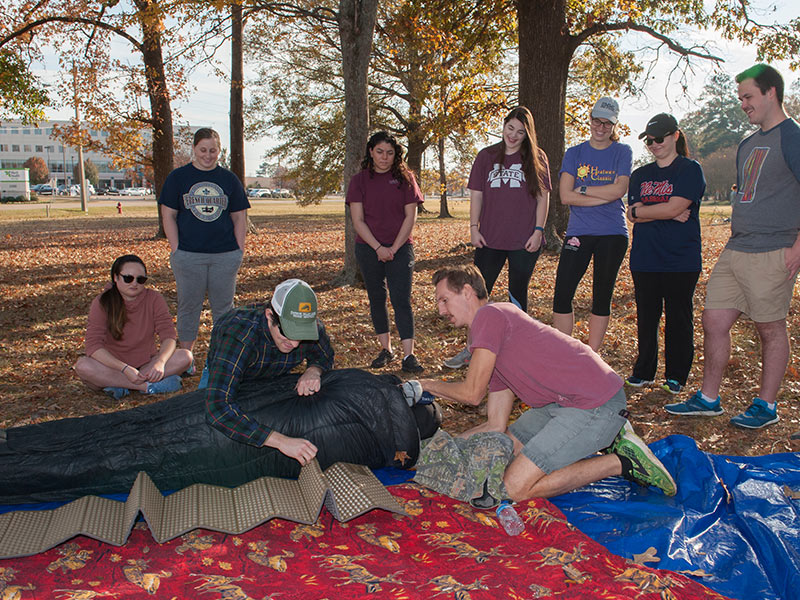
During one of those South Carolina summers, a 13-year-old girl leapt off a rock onto a beach whose sand was harder than it looked. “She broke her ankle,” Salaun said.
The tiniest movements jarred her with “agony,” he said, even as she was taken away on an immobilization board. Before she left, Salaun had applied to her broken limb a SAM (Structural Aluminum Malleable) Splint, a compact, lightweight support wrapped with ACE bandages.
He also did something that everyone from a modern-day Daniel Boone to a diehard homebody, or from the most experienced ER physician to a sophomore art major, might have done.
“I gave her an Advil,” he said.


